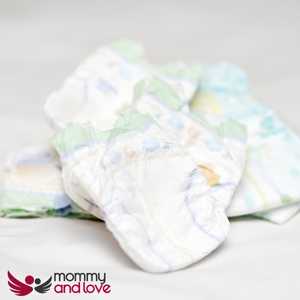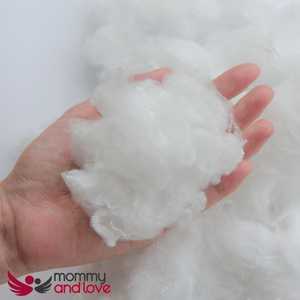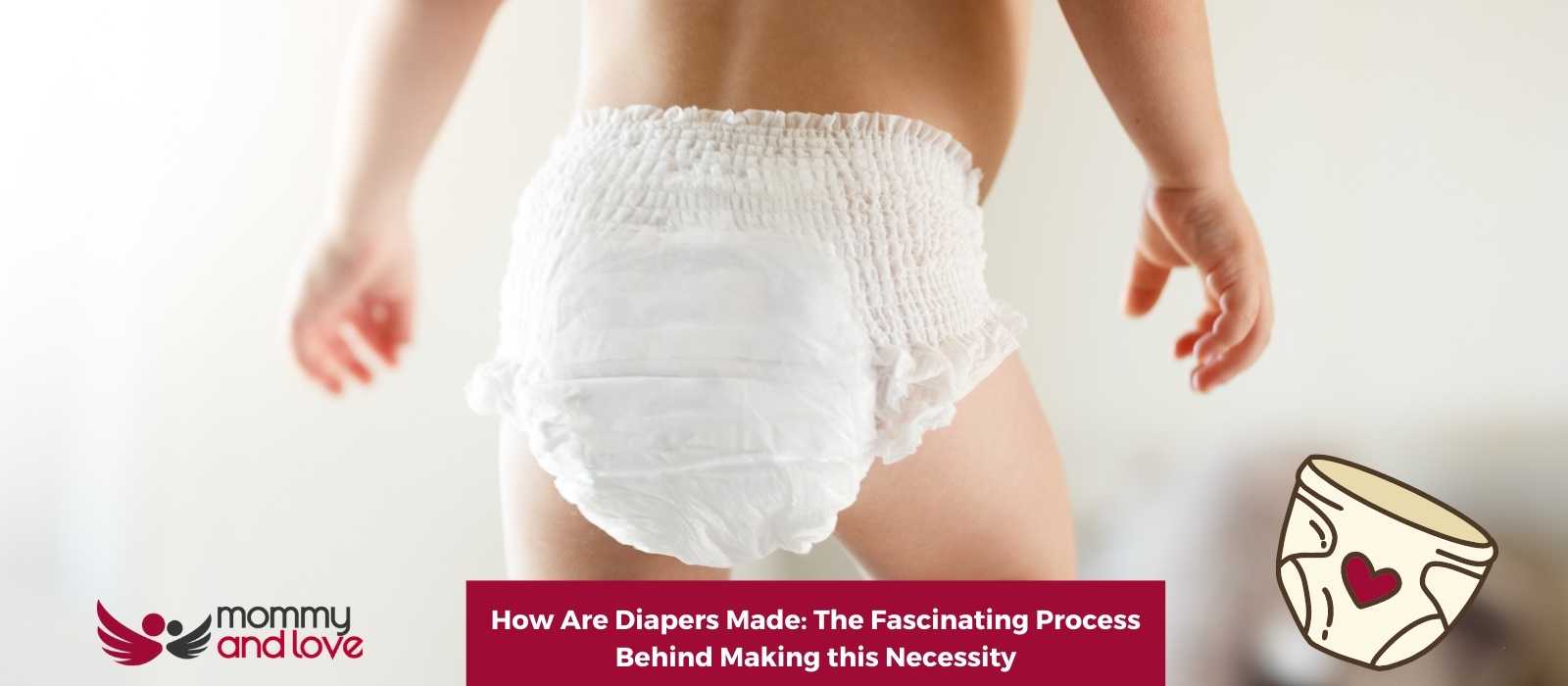It’s probably a safe assumption that most people don’t know how diapers are made. After all, it’s not a topic that is often discussed openly. But the process of making diapers is actually quite fascinating, and it’s something that we should all be aware of.
Parents will be dealing with diapers until their children are ready for toilet training. So in this blog post, we will take a look at the process behind manufacturing disposable diapers.
We will also discuss the different materials that are used, as well as the various steps involved in the production process. So if you’re curious about how diapers are made, keep reading!
What Are the Properties of Modern Disposable Diapers?

Modern disposable diapers are composed of a soft, absorbent inner layer and an outer cover that repels moisture.
The inner layer is made from a thin material called fluff pulp, which helps pull moisture away from the body.
They also contain super absorbent polymer (SAP) for better absorbency. The outer cover is made from a combination of polypropylene, polyethylene plastic, or paper, and contains chemicals that help reduce bacterial growth.
In addition to the fluff pulp and outer layers, modern diapers include other components such as tapes or fasteners and super absorbent material. Tapes or fasteners are used to close the diaper around the baby.
Superabsorbent particles are made from a cross-linked polymer that traps fluid and prevents it from being released even under pressure. These particles are also capable of holding up to 100 times their weight in water.
Raw Materials
Almost all modern disposable diapers use the same materials and only differ in a few things such as how much of the materials they use and their manufacturing process. One thing to note is that most of these diapers contain dioxins which the Environmental Protection Agency or EPA considers human carcinogens.
Here are a few of the most common materials of modern disposable diapers.
Polypropylene

Polypropylene is the most common plastic material used in diapers.
Polypropylene is used in diapers because it is soft, cheap to produce and makes a great waterproof cover.
Polypropylene has also been used in clothing fabrics as well as carpets and rugs.
Polypropylene is also used in food packaging as well as medical supplies. The material can be blended with other materials to make new products.
Polyethylene
Polyethylene (PE) is a thermoplastic, meaning that it becomes pliable when it gets hot and becomes hard again when cools. It is made of repeating units of ethylene, which is a colorless and flammable hydrocarbon gas. Polyethylene can be either linear or branched.
Diapers are made of Polyethylene because:
- It is lightweight, flexible, and soft, making it very comfortable to wear.
- It has excellent chemical resistance and stability.
- It has low water absorptivity.
- It has good impact strength, even at low temperatures.
- It is inexpensive to produce
Wood Pulp
Wood pulp fluff is the most common ingredient found in disposable diapers, . In fact, approximately 70 percent of a diaper is made of wood pulp. When we think of fluff pulp, we often think of thin sheets of paper, but it is actually made up of fine fibers that are separated from one another during the production process.
Fluff pulp is used in diapers because it is absorbent and it holds liquid while preventing leakage by forming a gel-like structure when wet. As a result, the gel will hold many times its original volume in water as well as in bodily fluids. It keeps a wet diaper feeling dry.
Velcro
Velcro is a type of strap which has a looped material on one end and a hook-like material on the other. The looped material can be hooked to the hook-like material and vice versa. This way, the two pieces can be attached together. The Velcro can be easily ripped apart from the other diaper material when required.
Those who do not know what velcro straps look like can think of diaper hooks and loops. These are basically two pieces of materials that are attached to each other like a belt or a chain. The hooks are present on one end while the loops are present on the other end.
Velcro is used in diapers because it helps secure them in place so that they don’t leak or slip off during movement or playtime. The design of these products ensures that they remain secure no matter how much your baby moves around during sleep or playtime. Velcro and loop fasteners also makes it easy for parents to keep the diaper secure.
Artificial Scents and Fragrances
The scent is a large part of what makes a diaper brand stand out from the crowd. It’s all about appealing to our senses of smell and touch. For example, when it comes to poop, scent can help mask some of the not-so-pleasant odors of a dirty diaper. Some parents prefer the option to choose a scented or unscented diaper. Others may find that their baby prefers one over the other based on their own sensitivity levels to particular fragrances
Typically, the fragrance is used in a diaper because it helps mask any unwanted smells, such as ammonia. Some babies also have sensitive skin, so we typically like to use products that have limited ingredients.
The fragrance or scent in diapers has no actual health benefits for your baby. They’re usually added to block out unpleasant odors from poop, but they’re not necessary for your baby’s health or well-being. Scented diapers are safe for your baby if you change them regularly and keep an eye out for any allergic reactions or skin sensitivities.
What Are the Parts of Modern Disposable Baby Diapers?
The parts of a disposable diaper are the waistband, the absorbent core, the absorbent polypropylene top sheet, the outer cover, and the fastening system. The waistband of most disposable diapers is what keeps the diaper in place on your baby’s body. Absorbent cores are made of absorbent materials that soak up urine and feces. The outer cover protects against leaks and keeps the absorbent core in place. The fastening system is used to attach the diaper to your baby’s body. There are a variety of different fastening systems, including snaps, velcro, and tabs.
Absorbent Core
The absorbent core of disposable diapers is made out of a variety of materials, including fluff pulp, sodium polyacrylate, and cotton. The type of material used in the absorbent core can affect the performance and comfort of the diaper. A composite distribution layer is placed between the pad and the cover sheet. For example, if the absorbent core is made out of the wood pulp, it may be less absorbent but more comfortable than a diaper with a super absorbent polymer core. Cotton-based absorbent cores are also more breathable and less likely to cause skin irritation than other materials.
The absorbent core is the heart of a diaper and the most important component of disposable diapers and is held in place by nonwoven fabric. It is made with what is called “air-laid” technology. The process begins with cellulose fibers being mixed in with super absorbent polymer (SAP).
These two materials are mixed together to make a pad formation at a ratio of 50% SAP to 50% cellulose fibers. A machine called an air-laid machine then takes this mixture of SAP and cellulose fiber, adds water to it, and blows it into a dovetail-shaped chamber that contains hundreds of tiny air jets.
The air jets create a vortex as they blow the mixture around in the chamber and as the mixture swirls around, it begins to form itself into a sheet of combined polymer and fabric. This sheet continues to form until finally, it lands on a conveyor belt that carries it out of the chamber. To apply various layers of polymer and fiber, multiple spray dispensers are required.
While the sheet is still soft and wet, it goes through another machine where tissue paper is laminated to both sides of it. This lamination process creates what we call the diaper core or diaper chassis.
The chassis can now be used in other manufacturing processes like baby diapers, feminine hygiene products and adult incontinence pads.
Absorbent Top Sheet and Back Sheet
The absorbent top sheet and back sheet of disposable diapers are made out of a variety of materials, including polypropylene, polyethylene and polyester. These materials help to absorb moisture and keep the baby’s skin dry. Additionally, they are soft and gentle on the skin, which helps to prevent diaper rash. choosing a diaper with an absorbent top sheet is an important part of keeping your baby comfortable and healthy.
A nonwoven fabric made from polypropylene, polyethylene and polyester is the main component of the absorbent top sheet of a diaper. These materials are produced through a process known as meltblown. This involves feeding polymer fibers through a series of tiny, heated pressurized nozzles. The heat melts the material and causes it to form into continuous filaments.
Air is then blown over the filaments, which causes them to swirl and collect on a rotating drum. The soft, fluffy material that collects on the drum forms an ideal base for the absorbent pad while a movable conveyer belt passes through. And then a roller is used to make sure the pads have a uniform thickness.
The second layer of nonwoven fabric sheets of polypropylene is then added to act as a wicking material and distribute fluid throughout the pad. The flat pad also contains superabsorbent polymers (SAPs), which are solid particles that have been grafted with acrylate groups, making them highly absorbent. SAPs can retain large quantities of liquid relative to their weight, making them ideal for disposable diapers.
Waistband
The diaper waistband is made out of a sturdy fabric that can withstand wear and tear. This fabric helps to keep the diaper in place, ensuring that your baby stays comfortable and dry all day long. Most elastic bands are also adjustable, so they can grow with your child as they continue to grow. Plus, the fabric is soft and gentle.
Leg Cuffs
The diaper leg cuffs are made out of a soft and stretchy fabric. They are comfortable to wear and will keep the legs of the average baby warm. The cuffs also help to prevent leaks.
Outer Cover
The outer cover of a disposable diaper is made out of plastic fibers. This plastic resin helps keep the diaper in place and keeps moisture from escaping. It is also important to note that some disposable diapers have an inner liner made out of nonwoven fabrics as well.
This liner helps to keep the baby’s skin dry and free from moisture. In addition, this liner also helps to protect the baby’s diaper from leaks. As a result, parents can feel confident that their baby will be comfortable and dry while wearing a disposable diaper.
Putting The Core Components Together
The three separate components, the absorbent pad, the top sheet, and the backing sheet, must be assembled. These three components come in long strips that must be connected using strips of tape or hot melt adhesives and then cut into diaper-sized sections.
The absorbent pad is fed onto a conveyor with the polyethylene bottom sheet to accomplish this. The top sheet of polypropylene is then fed into position, and the two sheets are linked by gluing heating, or ultrasonic welding. Other attachments, like strips of tape or Velcro, may be used as closures on the assembled diaper.
The lengthy roll is then divided into individual diapers, folded, and shipped.
Wastes and By-products
Diaper manufacturing produces few byproducts. In fact, the diaper companies rely on by-products from other industries. For instance, the absorbent material and polymers used in diaper manufacture are frequently leftovers from other chemical industries’ production lines. Although the polymer particles are too small for other purposes, they are ideal for diapers.
However, a significant proportion of nonwoven material and polymer particles are wasted in the diaper manufacturing process. To reduce solid waste, the diaper industry aims to maximize the number of diapers produced per square yard (meter) of material.
Furthermore, every effort is taken to recover any leftover fiber or polymer material from the forming chamber. However, due to filter clogging and other losses, this is not always possible.
How Are Cloth Diapers Made?
Modern cloth diapers are produced using different processes and techniques. But most of them are made of different natural fibers and materials including cotton, hemp, bamboo and microfiber. The most common type of cloth diaper is the flat diaper.
A flat diaper is a large piece of fabric that is folded and used as a disposable diaper. There are also prefold diapers that are similar to flats but have been pre-folded. They also have a diaper cover, sometimes called the shell.
Another type of cloth diaper is the fitted diaper. A fitted diaper has elastic around your baby’s legs and waist and is usually made from moisture-wicking fabric.
The last type of cloth diaper is the all-in-one (AIO). An AIO has a waterproof outer layer and an absorbent inner layer. It can be worn like a disposable diaper or snapped into a cover.
There are also several types of cloth diaper covers including wool, fleece and PUL. Wool is a natural fiber that is water-resistant and breathable. It can be used as a cover for fitted diapers or all-in-ones.
Fleece is a synthetic fabric that is water-resistant and can be used as a cover for fitted diapers or all-in-ones. PUL is a synthetic fabric that is water-resistant and breathable. It can be used as a cover for fitted diapers or all-in-ones.
Here are a few of the common materials used in washable diapers:
Bamboo
Bamboo is an eco-friendly and highly sustainable resource, making it a great choice for cloth diapers. Bamboo fabric is naturally softer than cotton and requires less water to grow. Because bamboo is so quick growing – the bamboo plant can grow up to 3 feet in 24 hours – it does not require the use of pesticides or fertilizers.
Bamboo fabric is biodegradable, breathable, anti-bacterial and hypoallergenic; making it perfect for babies with sensitive skin. Bamboo also wicks moisture away from the baby’s skin and helps to keep them cooler on warm days, while keeping them warmer in cool weather.
Cotton
Cotton diapers are made from cotton which is often the preferred choice of fabric for cloth diapers. It’s durable, breathable, and easy to care for and wash. There are many different types of cotton and you will find all kinds used in cloth diapers.
Cotton material is a natural fiber harvested from the seed pods of cotton plants. Cotton is soft and breathable, which is why it’s often the first choice for baby clothes, blankets, and diapers. Diaper companies have created special blends with other fabrics to make them even more absorbent and durable.
Organic cotton is grown without pesticides or chemicals that may be harmful to your baby’s skin. These fabrics are usually not treated with fire retardants or formaldehyde solutions during manufacturing either. Organic cotton is also more sustainable than non-organic cotton. Non-organic cotton production can harm wildlife habitats and pollute soil and water sources in the surrounding areas.
Hemp
Hemp is a plant that grows very quickly and densely. It is naturally resistant to pests and needs very little water to grow. This makes it an environmentally friendly choice when compared to cotton. Hemp fiber is also softer than cotton fiber and is more absorbent. However, hemp fiber may be more expensive than cotton.
Hemp is a type of cannabis Sativa that has been grown for its fibers for thousands of years. The hemp fibers are quite strong and durable, even when wet. Hemp cloth and diapers are not only sustainable, but also strong and durable, and can be used for multiple children or passed down through generations.
The market for hemp cloth diapers has grown significantly over the last few years because of the many benefits associated with using this fabric in cloth diapering products. Hemp has natural anti-bacterial properties that help keep your baby clean and fresh while they’re wearing their diaper.
The fabric also feels soft against your baby’s skin, which means you don’t have to worry about them getting a rash like they would with a traditional disposable diaper. Also, hemp diapers are much more absorbent than other types of fabrics used in cloth diapering products so they will keep your baby dry longer than other diapers.
Conclusion
So, how are diapers made? The answer is quite complex for both disposable and reusable nappies. Almost all diaper manufacturers use a similar manufacturing process that includes several key steps, only differing in the amount and quality of materials used. Understanding how nappies are made can help you appreciate their complexity and the effort that goes into producing this essential product.
We have come a long way since the first disposable diaper ever made where they used cellulose wadding instead of SAPs and diaper design keeps getting better. And although most diapers are still non-biodegradable diapers, if you want to minimize your solid waste and used diapers, there are biodegradable diapers on the market.

This article was written by: Gian MIller – Full-Time Writer, Baby Whisperer & Dad of 3.
Gian spends a lot of his time writing. A self-proclaimed baby whisperer, Gian has been through it all with his own children and is passionate about sharing his hard-won wisdom with other parents. When he’s not writing or changing diapers, you can find him playing the guitar or watching baseball (or preferably both at the same time).




